
Sugilite Gemstone: Properties, Meanings, Value & More
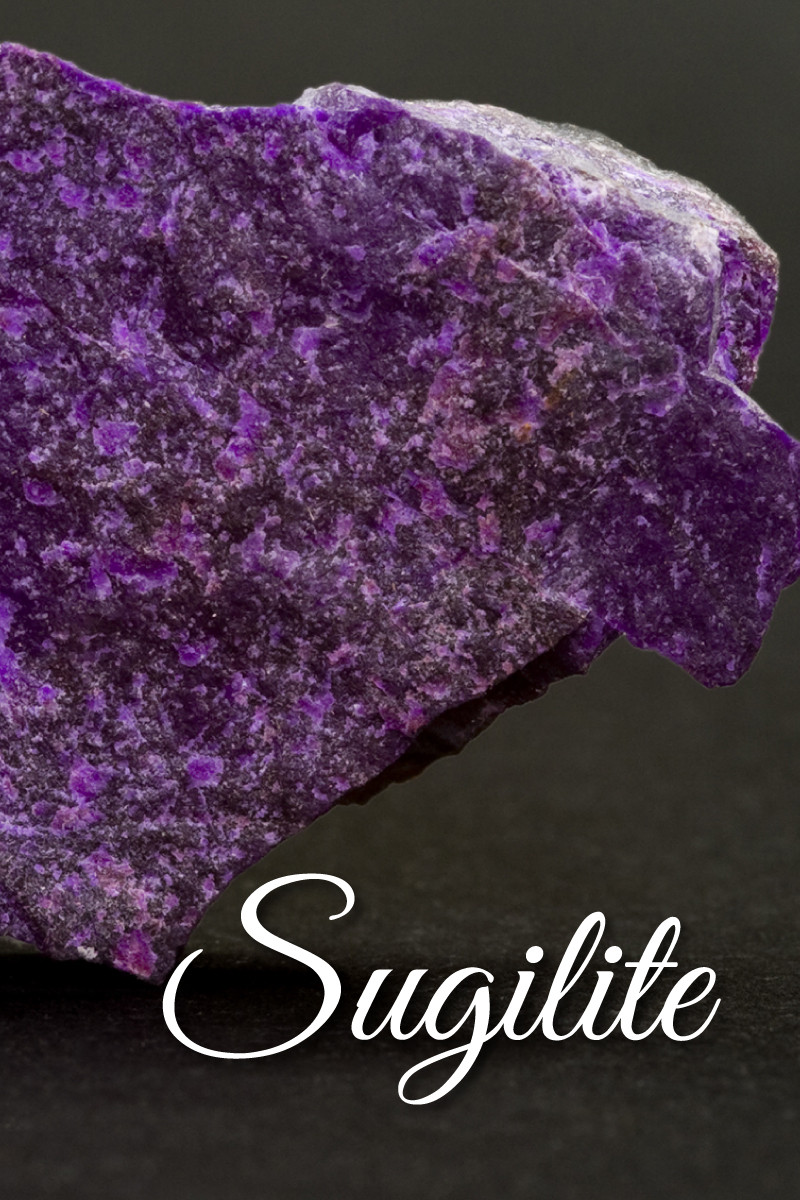 When you hear “purple crystal,” you probably picture amethyst or iolite. One underrated purple gemstone to put on your radar is sugilite, the rare but vibrant purple cyclosilicate mineral.
When you hear “purple crystal,” you probably picture amethyst or iolite. One underrated purple gemstone to put on your radar is sugilite, the rare but vibrant purple cyclosilicate mineral.
Amethyst is also a silicate, so is sugilite the same as amethyst? No, sugilite and amethyst are distinct minerals.
Is sugilite a real gem? While its enchanting hue is rare in nature, sugilite is a real gemstone!
Discovered in the mid-20th century in Japan, sugilite is better known in Asia than North America. However, Westerners may recognize a couple of sugilite appearances in pop culture!
In 2013, actress Naomi Watts wore sugilite earrings on the red carpet at the Critics Choice Awards. Plus, the popular animated show, Steven Universe, featured a sugilite character voiced by singer Nicki Minaj.
By the end of this guide, you’ll know everything about sugilite benefits, value, properties, and more!
To start: what is the crystal sugilite?
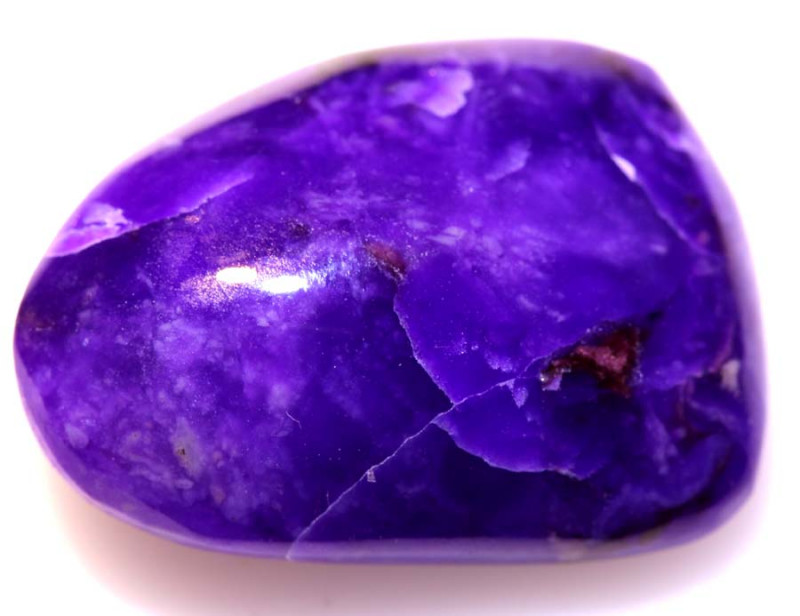
About Sugilite Stone
Sugilite, or sugulite, is a semi-precious gemstone of many names. Some monikers include lavelite, luvulite, Royal Azel, Royal Lazelle, Cybelene, and Wesselite.
Most alternate names originated from specific sugilite deposits, like the South African Wessels Mine (Wesselite) and Hotazel mines (Royal Azel and Royal Lazelle).
Is sugilite a birthstone? Sugilite is an alternate January birthstone, though some say violet sugilite blesses anyone born from December 21 to January 19 — AKA: Capricorn season!
Despite that, sugilite is a zodiac stone for Capricorn’s fellow earth sign Virgo. Virgos are practical but often too hard on themselves, so sugilite brings acceptance and self-compassion to curb self-criticism.
Sugilite has more astrological significance as a star stone for the planet Jupiter. This planet governs exploration, luck, and curiosity — similar feelings you might experience upon discovering a raw sugilite crystal!
Mineral Characteristics
Sugilite is a cyclosilicate mineral belonging to the Milarite-Osumilite group. This group encompasses similar, rare cyclosilicates, which are widely unknown outside of experienced gemstone collectors.
If those are unfamiliar to you, sugilite also has a similar chemical structure to tourmaline and aquamarine. Charoite is also commonly mistaken for sugilite.
Sugilite’s chemical composition gets a bit tricky. Its complex formula makes it a sodium potassium lithium silicate mineral. However, iron, manganese, and aluminum are usually present and can replace each other, leading to different colors and varying sugilite crystal properties.
On the Mohs mineral hardness scale, sugilite ranks between 5.5 and 6.5, a mid-range scratch resistance.
You’ll find the rest of the mineralogical sugilite properties below!
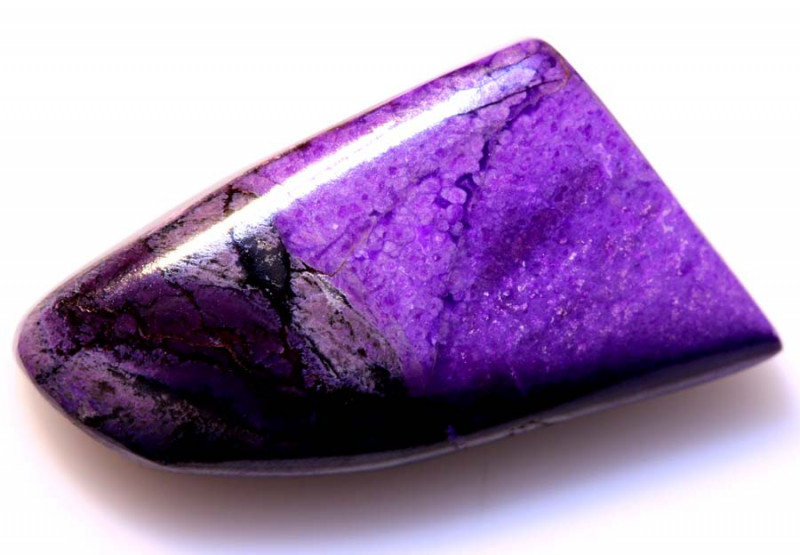
Sugilite Specifications & Characteristics
Color: Generally purple, pink, or fuschia; May be pale brownish-yellow, dark rose-red, bluish-purple, or colorless
Crystal structure: Hexagonal
Luster: Vitreous (glass-like) to dull or waxy
Transparency: Translucent to opaque
Refractive index: 1.59-1.61
Density: 2.74-2.80
Cleavage: Poor to indistinct on [0001]
Fracture: Uneven to conchoidal
Streak: White
Optical Effects: Chatoyancy, rarely
Pleochroism: Weak
Moving from geological properties into metaphysical properties, what does the sugilite stone symbolize?

Sugilite Gemstone Meaning
Sugilite’s name comes from the man who discovered it: Japanese petrologist Professor Ken-ichi Sugi. The name is commonly mispronounced, so let’s clear up any confusion: the correct pronunciation is SOO-ghee-lite, with a soo like “soon” and a hard g like “goose.”
Sugilite symbolism includes balance, love, and rebirth. Specific sugilite colors may grant different representations, though.
Blue sugilite, sometimes labeled as Richterite, is nicknamed the “Stone of Guidance,” associated with emotional balance following a shocking or traumatizing experience.
The purple and black sugilite meaning is one of spiritual protection, ambition, and the mysterious allure of the unknown.
One alternate name for sugilite, Cybelene, may reference the Greek myth of Cybele and Attis, which contains an origin story for the violet flowers that share sugilite’s coloring.
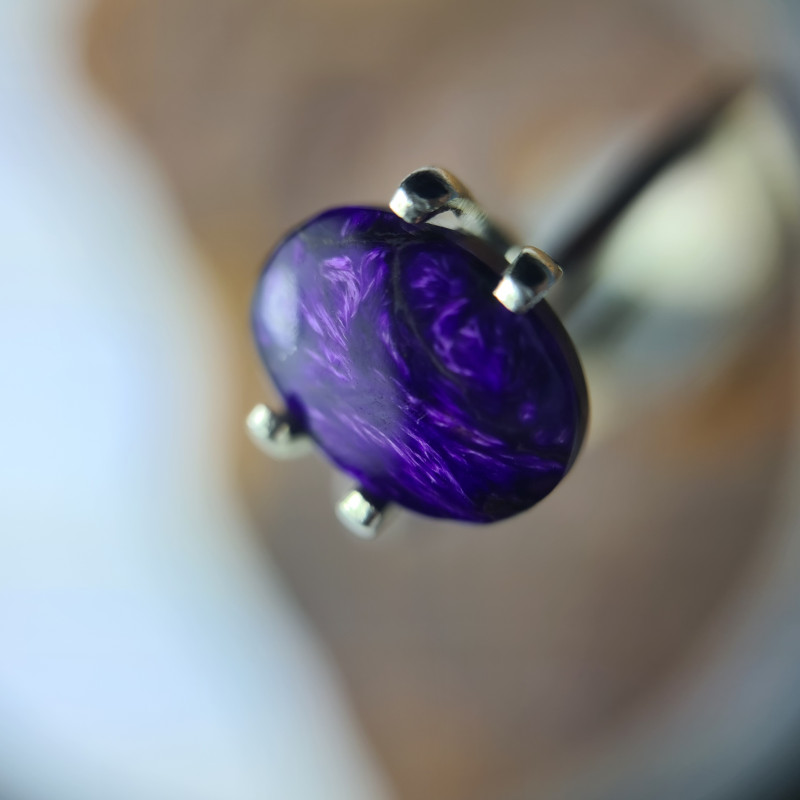
Sugilite Mythology: Cybele & Attis
The multi-part myth begins with Cybele, a Phrygian goddess, being secretly impregnated by Zeus after rejecting him, then subsequently birthing a demon. The demon scared the gods, so they emasculated him, his spilled blood forming an almond tree.
Later, a river god’s daughter, Nana, ate from the tree, unknowingly impregnating herself. Upon delivering, she abandoned the baby, and shepherds raised him as Attis. He eventually became so handsome, Cybele fell in love with him! (Ancient myths and incest, what can you do?)
However, Attis fell in love with another woman. In revenge, Cybele drove Attis so insane, he stopped at a pine tree and emasculated himself before taking his life. There, the first-ever violets bloomed where his blood fell.
Every year during the Ritual of Attis, folks cut a pine down, covered it in violets, and carried it to Cybele’s shrine to mourn for three days before Cybele “resurrects” Attis, followed by celebration.
Phew, ancient myths are intense! For more everyday issues not related to fruit-induced pregnancies, what are the healing properties of sugilite?

Sugilite Healing Properties
By the nature of their colors and vibrations, crystals can act as healing stones. Is sugilite a healing stone? Absolutely!
As a purple gemstone, sugilite metaphysical properties encompass intuition, inspiration, and spirituality.
How do you wear sugilite? Most crystal healers recommend wearing sugilite jewelry on the right hand for the most effective healing.
So, what is sugilite good for? Let’s look at the specific sugilite healing properties.
Physical Healing
Physically, sugilite stones are commonly used for treating headaches, epilepsy, and wounds. Wearing a sugilite pendant is said to make your heart stronger.
Blue sugilite may support the endocrine system, easing hormone-induced mood swings and reducing overactive fight-or-flight responses.
How do you use sugilite for emotional issues?
Emotional Healing
Sugilite’s emotional benefits may include lowering stress and aggressive tendencies, along with nurturing positivity and spiritual love.
Many who use the crystal, in a sugilite ring or sugilite bracelet for instance, report higher sentimentality and deeper feelings of connection with the people and nature around them. Others claim sugilite encourages forgiveness, bringing the freedom of release to those bound by resentment.
Chakra Healing
The sugilite chakra graces the crown, the swirling halo of light above your head. The crown chakra represents spiritual ascension and divine connection.
A crown chakra blockage can lead to feelings of aimlessness, isolation, or insomnia. You can balance the chakra to feel enlightened and in-tune with the universe using sugilite.
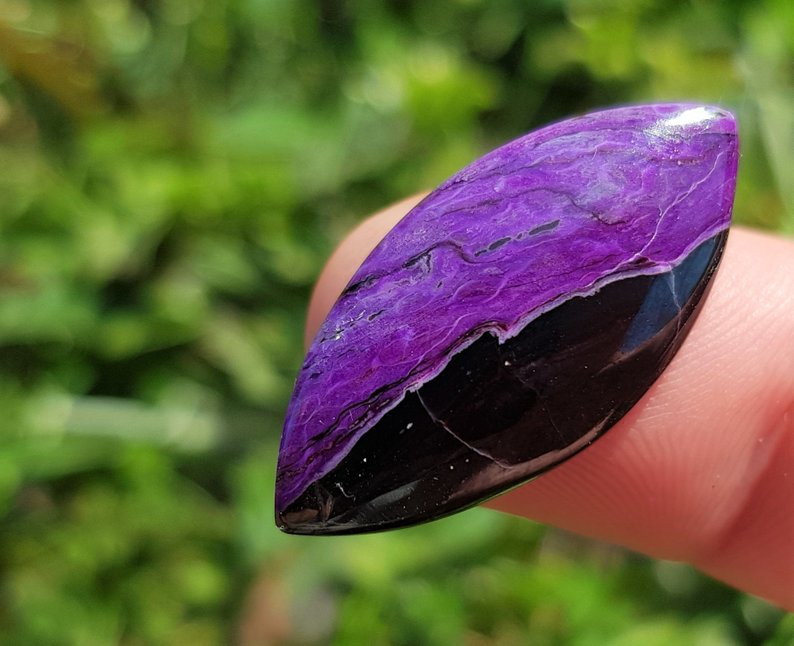
Sugilite Gemstone Properties
Experts look at a particular gem’s value factors when grading. Color is paramount in assessing sugilite’s value; however, cut, transparency, carat weight, and treatments may affect its value, too.
Color
Sugilite can be pale yellow or colorless, but gem-quality specimens are pink to purple. The purple hue comes from its high lithium content and magnesium presence. Deeper coloring equals a higher value.
The two main types of sugilite coloring are the rarer solid-colored stones and the more common patterned stones. Black sugilite patterns can be blotchy, layered, or veined. White spots from pectolite are also common. Black splotches won’t affect the value if the overall color is still deep. However, deep purple mixed with lighter hues can lower the value.
Clarity & Transparency
Sugilite gemstones can be translucent or opaque, but translucent sugilites are very rare and often have a cloudy appearance. Sugilite gel — highly translucent specimens — rarely show inclusions.
Sugilite’s clarity grade (the amount and visibility of inclusions) is usually opaque. The most common inclusions are manganese oxides, which create brown or black coloring. If included, sugilites are fibrous, with the fibrous bands sometimes producing chatoyancy, the “cat’s eye” effect.

Cut
While often left rough, the most common sugilite cut is the cabochon. However, some translucent sugilite stones are faceted.
If a specimen displays chatoyancy, it must be cut as a cabochon. Other common cuts are sugilite beads and carvings.
Carat Weight
Despite its rarity, sugilite grows to fairly massive sizes. Mining specimens over 10 carats is common, so the value per carat doesn’t change with size.
Treatments & Synthetics
Treatments aren’t common for sugilite, though sometimes it's heated to lighten very dark coloring. Synthetics and simulants, however, are more common.
It’s important to be cautious about whether you have genuine sugilite or fake sugilite. Some common sugilite simulants include dyed beryl, marble, quartzite, or magnesite. Others are man-made, like imitation sugilite formed of ceramic or glass or block sugilite composed of crushed sugilite bound by resin.
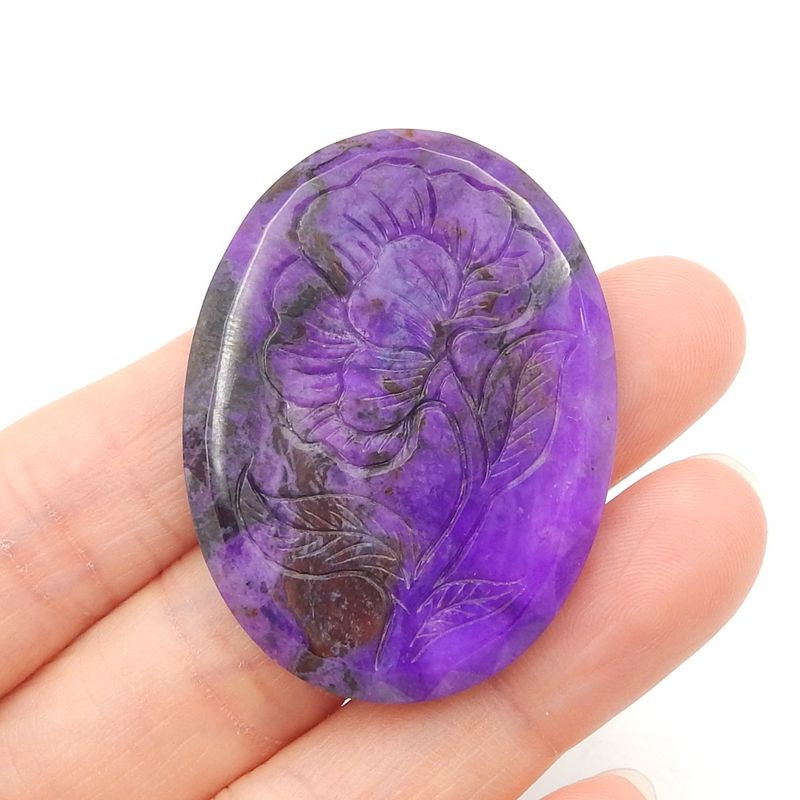
Sugilite History
A relatively new gem, sugilite was only discovered in the last century! Japanese geologist Ken-ichi Sugi made the first discovery in 1944.
Sugi discovered sugilite on Iwagi Island in southwest Japan, but he didn’t know he was making a new discovery. Instead, he believed it was a mineral similar to eudialyte. In fact, the specimens uncovered were very small yellow crystals, not of gem-quality.
It wasn’t until 1976 that sugilite received an official mineral description from distinguished mineralogist Nobuhide Murakami and colleagues. Unfortunately, Sugi would pass away before seeing the result of his discovery, but he was honored posthumously by the stone bearing his name.
Between 1944 and 1976, sugilite made other appearances around the world. In 1955, miners in central India found dark pink sugilite crystals, but they couldn't be cut.
Arguably the most significant discovery occurred in 1975, when a thin, deep purple sugilite seam appeared in the Kalahari Manganese Field near Hotazel, South Africa.
The Kalahari deposit produced the first gem-quality sugilite material, kicking off its widespread association with purple hues. By 1979, miners found another huge deposit estimated to have 10-20 tons of sugilite underneath the original Kalahari deposit, but its depth (3,200 feet underground) has prevented miners from attempting to uncover most of it.
Sugilite received classification as a “rare gem” in 1980, raising its price. A few more small deposits have been discovered, but sugilite remains rare.
That said, how does sugilite form?
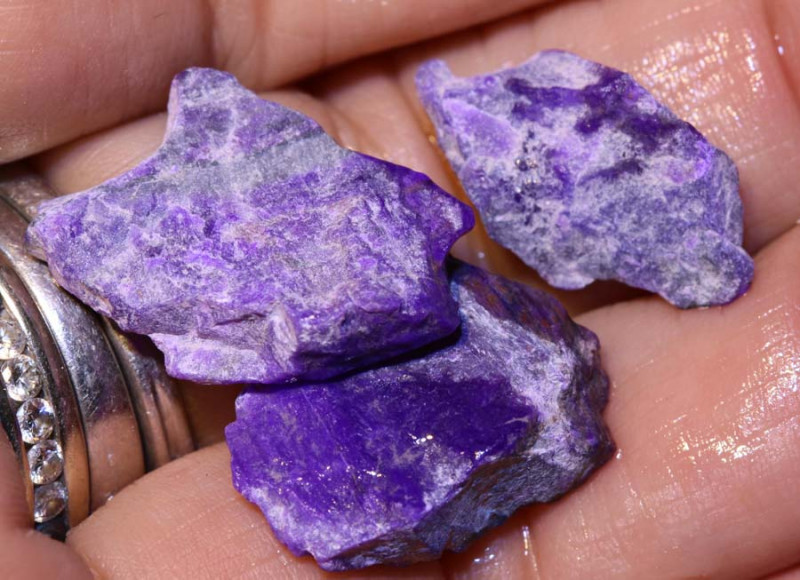
Sugilite Origins & Sources
Sugilite commonly occurs within rocks made up of numerous minerals. Gem-quality sugilite raw forms in stratiform manganese deposits, like those in South Africa. However, the mineral can also form in aegirine-bearing igneous rocks.
Sugilite can occur as a primary mineral in igneous rocks or a secondary mineral in marble. For reference, primary minerals form from the original rock, while secondary minerals form when the rock is weathered and chemically changed.
Now, where does sugilite stone come from?
Mining Locations
Currently, sugilite only forms in six places worldwide. As you know, South Africa’s Kalahari locale is currently the only commercial source of gem-quality sugilite.
The other sugilite deposits are in:
Australia
Canada
India
Italy
Japan

Sugilite Stone Price & Value
The highest-valued sugilite crystals for sale are translucent with bright purple, solid coloring. Called sugilite gel, these specimens are like chrysoprase in their translucence and range from $15 per carat for low-grade stones to $150 per carat for high-grade stones.
Why is sugilite so expensive? Its rare gem classification and the lack of gem-quality deposits are behind sugilite gel’s high price point.
However, there are other affordable options!
The majority of commercial sugilite is opaque with varying purple coloring. Low-grade stones in this category are typically $3 per carat, and richer shades of purple command higher prices. Top-grade opaque sugilite is usually around $6 per carat.
Impure sugilite (sugilite combined with other minerals like chalcedony) and block sugilite are often even more affordable than opaque sugilite.

Sugilite Care and Maintenance
Sugilite isn’t the hardest mineral, but its poor cleavage and relatively good tenacity means it can be pretty durable in jewelry.
However, we recommend buying sugilite jewelry with protective settings, particularly for sugilite rings.
We don’t have much research on the effect of chemicals or temperature changes on sugilite, but it’s best to avoid contact with either to be safe. We recommend cleaning the stone with warm water, mild soap, and a soft brush.
Sugilite, Spice, and Everything Nice!
By now, you can see why this rare stone sugilite has captured hearts and imaginations. From its almost alien fuschia coloring to its fascinating history, sugilite is a captivating and underrated gem. Turn heads and raise your spirit with your own sugilite stone!
Search the Gemstone Encyclopedia
Related Auctions
Related Articles
Originally the Birthstones or gemstones were associated with a zodiac sign or the month of a individuals birth. Find out what your stone is and view the stones we have for sale
8th Feb 2021
There are dozens of quartz and chalcedony gems with various colors and patterns. Learn all about quartz properties and every type of quartz, from amethyst and agate to plasma and phantom quartz!
15th Oct 2020
Hackmanite is a pink to violet sodalite gem known for its unique color-change and luminescence. Learn why hackmanite is special, from its rare qualities to the types of hackmanite jewelry available.
28th Mar 2018
Latest Articles
Yugawaralite is a rare colorless, white, or pinkish zeolite crystal named for its discovery in Yugawara, Japan. Here we uncover the multifaceted history, properties, prices, and uses of yugawaralite.
24th Mar 2025
Simpsonite is a lesser-known mineral known on the gem market for its durability, yellow-orange color, and rarity. Discover all the properties, uses, prices, and history of simpsonite.
3rd Mar 2025
Kurnakovite is a colorless crystal related to inderite and rarely faceted but known among collectors. Explore the mineral traits, history, prices, and more in this kurnakovite guide.
17th Feb 2025
Article Categories
How To's is where you will find helpful articles from gem Rock Auctions on how to cut gemstones, select gemstones and buy gemstones.
9 Articles


![10 RING SIZE RARE SUGULITE SILVER [SJ4037]](https://liveplatforms-production.b-cdn.net/tenants/gr/uploads/images/555000-559999/559596/530c339542bae.JPG?width=480&aspect_ratio=1001%3A1000)
![6.5 RING SIZE RARE SUGULITE SILVER [SJ4036]](https://liveplatforms-production.b-cdn.net/tenants/gr/uploads/images/555000-559999/559595/530c32cdd55f0.JPG?width=480&aspect_ratio=1001%3A1000)
![7.5 RING SIZE RARE SUGULITE SILVER [SJ4024]](https://liveplatforms-production.b-cdn.net/tenants/gr/uploads/images/555000-559999/559584/530c2d28807d0.JPG?width=480&aspect_ratio=1001%3A1000)
